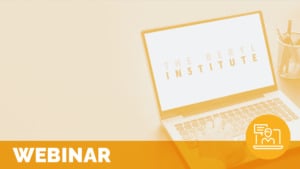Going Off on a Tangent: Exploring the Possibility of Process Change
Published January 24, 2022


Most people are familiar with the quote by the Greek philosopher Heraclitus, “Change is the only constant in life.” As wise and true as these words are, change still catches most of us by surprise. In some people, the fear of change can even be anxiety-provoking (a condition known as metathesiophobia). While most of us have a manageable discord with change, it doesn’t stop us from feeling uneasy when we’re subjected to it.
As I sat in my office in the hospital volunteer services department where I was employed for many years, including through the pandemic, it became very clear to me that change was inevitable and necessary. Every staff member had to pivot, a term I’ve associated with change during this season. We could no longer do things the way we used to if we wanted to have any hope of staying relative during this healthcare crisis.
To be honest, and in hindsight, halting our volunteer program for several months was a blessing in disguise, as it gave us the opportunity to analyze our processes, examine our options, and pivot, something we might not have been able to do as easily before the pandemic. We were able to accomplish this through something referred to as “process mapping,” which allowed us to visualize our current process, consider possible options or tangents, and lead the change we needed through a well-thought-out plan.
Whatever the motivator for the change you wish to see in your process (no matter your industry), I offer to you a few simple steps to get you “going off on tangents,” which will hopefully lead you down the path of improvement. Consider the following steps as you think about the process that you want to change:
- Draw a flowchart of the process as it stands today. This is called process mapping (you can read more about the topic on https://www.lucidchart.com/pages/process-mapping). This can be done on a computer using a program like Visio or PowerPoint or on a piece of paper. Draw a box and write the first step in your process (what triggers that start of that process?). Draw an arrow that then takes you to the next step(s). In the world of process mapping, certain shapes mean different things, but you don’t have to get that technical if this is new to you. Simple squares with arrows indicating next steps will work out fine (see the sample flowchart on making pasta found on https://d2slcw3kip6qmk.cloudfront.net/marketing/pages/chart/seo/process-maps/discovery/process-map-pasta-updated.svg)
- Review each step in the process and consider alternatives. Here are a few questions to get you thinking: Is this the only way to do this step? If this is a manual step, can it be automated? Can it be omitted or outsourced? Don’t be too quick to kibosh an idea – after all, it’s just something to consider. In the sample flowchart on making pasta, what if we put tomato sauce in the pan instead of water? Would it still cook the pasta? Or what if we put the pan in the oven instead of the stove? Be creative with alternatives. TIP: Several brains are better than one. Invite team members or stakeholders to share their input. This can be a fun team-building activity.
- Draw out the flowchart with the alternative you are considering. Invest some time and thought into thinking about the value each alternative adds and the risks it poses. Would you consider this alternative an improvement (i.e., does it cut back on time or resources)? If so, then this alternative might be worth adopting. Remember the flowchart for making pasta? I imagine that someone must have considered creative alternatives to the traditional pasta-making process. If that were not the case, we would not have enjoyed the famous baked feta pasta recipe that went viral in 2020 on TikTok (https://fedandfit.com/feta-pasta/).
If the alternatives you considered did not yield any changes, you may have a solid process that withstood testing. You can at least say that you’ve explored the possibility of change. At a minimum, this got the creative juices flowing for you.
If you are ready to adopt some changes to your process, I encourage you to read up on topics such as change management and communication planning. Other resources for your consideration are:
- Plan.Do.Check.Act – a proposed model for redeploying volunteers during COVID-19 by Joan Cardellino, CAVS
- Managing Up! – a VSys Voices Webinar on how to help volunteer leaders “be at the table”
Depending on the complexity of the proposed changes, you may need to socialize the idea with key stakeholders before launching forward. Be prepared to socialize this change and communicate why the change is taking place. If it’s a simple enough change to implement, just remember to update your flowchart. These are keepers and can be very valuable when training others on your processes.
Author Bio:
 Karina Vargas, CAVS, CompTIA Project+ has over 20 years of experience in volunteer management in a variety of settings. She is no stranger to the world of giving and serving. She has experience at all levels of volunteering, ranging from working with Board-level professional volunteers to high school students wanting to get exposure to potential career paths. She spent over ten years managing volunteers for a large children’s hospital in Southern California where she developed volunteer leadership programs, presented interactive customer service trainings, and provided expert-level technical and leadership support to their volunteer program. She worked closely with the VSys team to optimize her organization’s use of VSys One, and her suggestions led to several improvements of VSys One software.
Karina Vargas, CAVS, CompTIA Project+ has over 20 years of experience in volunteer management in a variety of settings. She is no stranger to the world of giving and serving. She has experience at all levels of volunteering, ranging from working with Board-level professional volunteers to high school students wanting to get exposure to potential career paths. She spent over ten years managing volunteers for a large children’s hospital in Southern California where she developed volunteer leadership programs, presented interactive customer service trainings, and provided expert-level technical and leadership support to their volunteer program. She worked closely with the VSys team to optimize her organization’s use of VSys One, and her suggestions led to several improvements of VSys One software.
Karina is a Certified Administrator of Volunteer Services (CAVS) and holds a bachelor’s degree in Human Services from California State University, Fullerton. After completing a certification in project management, she joined VSys One as a Solutions Architect. In this role she merges her healthcare volunteer management experience, her technical abilities, and her love for helping people and programs grow. When she is not at work, you can find Karina driving her kids to softball and baseball, writing music for TV and film placement, or helping her husband in his taco catering business.
Related content
-
Culture & Leadership | Infrastructure & Governance
Developing Multidisciplinary Committees for Patient Experience Effectiveness
Published June 26, 2025

This webinar explores how to move beyond recognizing the value of patient experience to embedding patient- and family-centered care into organizational culture. Learn how Patient Experience Committees, including a successful Cleanliness Committee, have driven improvements in HCAHPS scores, engagement, and collaboration. Discover strategies for structuring a Patient Experience Steering Committee with multidisciplinary subcommittees aligned to
Learn more -
Culture & Leadership | Infrastructure & Governance
Exploring the Foundational Frameworks to Build a Strategy for Experience Excellence
Published January 25, 2022

Learn about tools and resources to assess your progress and support your journey to transform the human experience in healthcare.
Learn more -
Infrastructure & Governance
The Role of Revenue Cycle in Elevating the Human Experience in Healthcare
Published December 8, 2021

This paper, published in collaboration with Healthcare Financial Management Association, explores how revenue cycle plays an integral role in a person’s experience well before and after a clinical engagement.
Learn more
